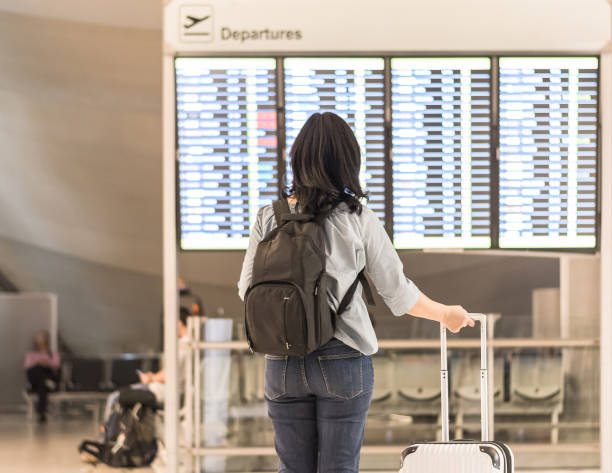How to Avoid Getting Sick on a Plane | Flightlayaway
With the spread of COVID-19, you might be concerned if you have an upcoming flight. However, according to experts, the risk of catching a viral infection on a plane is actually very low.
One of the worries among many passengers is that because the cabin of a plane is confined with lots of people breathing in the same air, viruses will spread a lot easier. But, the majority of aircraft have very modern air supply systems that filter all recycled air and are almost guaranteed to eliminate the possibility of any virus transmitting through the air.
Just like anywhere you go, the spread of a virus, illness or — more specifically — coronavirus on a plane is more likely through physical contact with other people or surfaces.
That’s why, if you have an upcoming flight, it’s important that you take many of the precautions that you would in public elsewhere, as well as a few extra measures. We’ve put together a list of essential tips to protect you from COVID-19 while flying, with a few extra things that you might want to consider for added protection. This can also be applied to stop the spreading of other viruses and illnesses.
Hand Washing and Sanitizer
Regular handwashing and hand sanitizers are being cited everywhere as the number one thing to protect against micro-organisms and COVID-19 spreading and that’s no different when travelling on a plane.
Regularly wash your hands for 20 seconds at a time and carry an alcohol-based hand sanitizer to apply in more immediate situations.
Don’t touch your face Another tip that also isn’t exclusive to travelling on a plane is to not touch your face, which is a lot harder than it sounds, particularly if you have a runny nose or itchy eyes. If you must touch your face, keep a clean tissue nearby to act as protection, then dispose of it and use hand sanitizer after.Wipe Seat Area Down
Cabin crew will clean the cabin in-between flights. However, bringing and using your own antibacterial wipes to kill any germs around your seat can go a long way to ensure that your personal space is free of infection.
In 2018, CBC released a report on the dirtiest parts of a plane that highlighted headrests, seat-pockets, seat-belts and table trays as the least clean surfaces. Make sure to wipe down these areas thoroughly.
Don’t Bother With Gloves
While gloves may add a protective layer to your hands, contrary to popular belief, when it comes to spreading germs, they’re actually worse than leaving your hands bare.
Because people have a sense of security when they wear gloves, they will touch things that they would ordinarily be wary of touching with their bare hands, such as toilet doors, seat handles and seat-back trays. This results in germs being spread further and increases the risk of catching something if you were to accidentally touch your face.
Face Mask
Face masks will by no means guarantee that you’re safe from infection. However, it’ll cut down the likelihood that you’ll be infected. One of the main causes of germs spreading — particularly with coronavirus — is respiratory droplets entering your mouth or nose when another infected person sneezes or coughs within close proximity. Obviously, a face mask adds a layer of protection to your mouth.
However, wearing a mask all the time is not only ineffective, but it might also increase the risk of infection. The World Health Organization (WHO) advises replacing your face mask if it becomes damp, as microbes thrive in warm and moist environments.Don’t Use Your Seatback Pocket
Even if you wipe it down, due to its position, the seat-back pocket is likely to be one of the least looked-after and hardest-to-clean parts of the cabin. If you’re trying to keep yourself free of germs, it’s wise to not use it, particularly if you’re using it to store food or drink.
Choose a Window Seat
The more isolated you are in the cabin, the less chance there is that you’ll catch something from other passengers. Pre-select your seat and sit in a section of the plane that is away from busy areas of the cabin.
The best place to sit in order to minimise how much you come in contact with people is a window seat that’s far away from the toilet. Sitting in a window seat means that you won’t have other people in your row coming in contact with you if they need to get up nor will people brush past you as they move down the aisle.
You can pre-book your seat on a number of airlines with Flightlayaway.Bring Your Own In-Flight
Entertainment
If your airline has an in-flight entertainment system, you might want to consider using your own personal device for in-flight entertainment instead, particularly if it’s a touch screen.
In-flight entertainment will have been touched by many people before you and you can’t trust that they have been as germ-cautious as you are
Avoid Touching Door Handles
Plane toilet doors are one of the most germ-ridden sections of the cabin. If you need to use the toilet during your flight, take a clean tissue with you so that you can avoid touching the handles of the door when you enter and leave the toilet.
Keep Your Shoes On
Don’t get too comfortable on the flight. Walking around the cabin barefoot is poor flying etiquette and a big no-no at the best of times, so don’t even think about it when you’re trying to protect yourself and others from infection.
Avoid Junk Food and Caffeine
Eating high-sugar, high-fat foods or caffeine will weaken your immune system and make you more susceptible to catch an illness, so make sure that you eat something that contributes towards a balanced diet.
If you want to be extra cautious, you might want to pack your own food from home to take with you on the plane. Not only will this allow you to control what goes into your food, but it will also ensure that you’re the only person to have touched it.
Eat Foods High in Vitamin C
Ask For Cutlery
If you need to eat something during your flight, ask one of the flight attendants to provide you with cutlery. As mentioned earlier, your hands are one of the biggest carriers of microorganisms, so using them to put food in your mouth is a bigger risk than cutlery.
Keep Yourself to Yourself
One of the bigger risks in catching an illness when travelling on a plane lies in how close you are situated to other people. With coronavirus, one of the biggest causes of transmission is coming in close contact (within six feet) of someone that is infected.
But, just because you’re sat next to someone, it doesn’t mean you have to come in contact with them. Keep yourself to yourself and save the small talk for another time.






Comments
Post a Comment